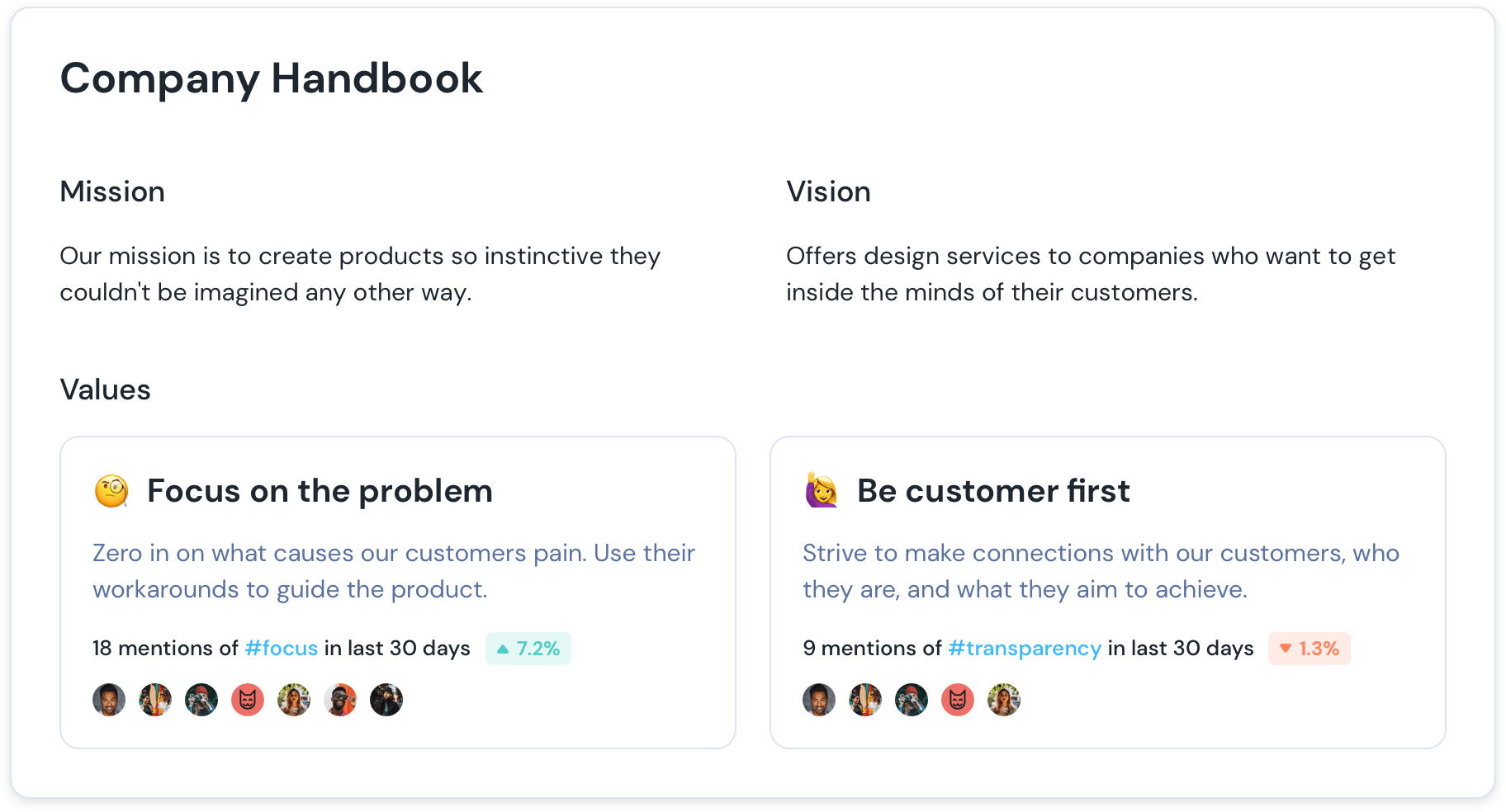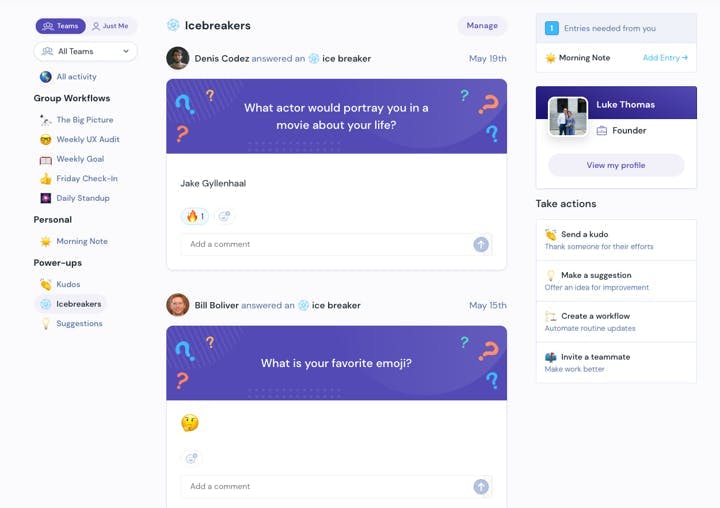21 Must-Have Intranet Features For the Modern Intranet

At Friday, we believe every company needs a Cloud HQ for work, especially for hybrid and remote work. In a world where the office is now optional, we can no longer rely on a physical space to create connection, awareness, and visibility into what’s going on at work. As a result, we need to recreate this context in a digital-first way, otherwise, people will feel disconnected, misaligned, and unaware. And the business will suffer.
As we discussed in a previous post on the pitfalls of the intranet, this category of tool tends to drive mediocre business outcomes. In this post we’re going to outline the key features and functionality that your digital company headquarters needs to be successful.
Unlike most other articles you may read, we are going to list features, but we’re also going to do our best to focus on the must-haves. Most intranet providers try to throw the kitchen sink of features at you, with the hope that one of them “sticks.” This is a flawed approach and there’s a better way.
With that being said, let’s jump in!
What is the #1 goal of the intranet?
The key job to be done for the company portal or intranet is to centralize the most important stuff at work that everyone needs to know.
Unlike workplace chat, the intranet aims to separate the signal from the collaborative noise. We love work chat, but not every conversation should be treated the same way. An announcement from the CEO is much more important than someone asking, “does anyone want to go grab lunch?”
In other words, the intranet:
- Glues your most important work together
- Acts as a filter, showcasing the most important context and information.
What are the most important jobs to be done for the company intranet?
For those unaware with the jobs-to-be-done theory, the high-level idea is that people ‘hire’ products to perform a job or to deliver an outcome. We believe an intranet needs to answer the following questions for the average employee.
1. What are people working on?
No, I’m not talking about micromanaging or a project management system, but instead, the intranet needs to provide an “at-a-glance” view into what someone is working on. Most importantly, this information needs to be current and up-to-date. Typically, this information is shared through a high-level status update or a snippet.
2. How does my work fit into the bigger picture?
Employees need to know how their day-to-day work connects to larger strategic, organizational objectives. Oftentimes these high-level initiatives are hidden or not exposed on a regular basis.
3. Who do I work with?
At the office, it was easier to get to know people and understand what makes them tick. In a world of multiple office locations and remote work, it’s easy to feel your coworkers are robots, especially when you spend most of your day communicating behind a screen.
4. What do I need to know?
The intranet needs to be a place where the most important information lives, especially for new employees. It needs to answer commonly asked questions without people as the bottleneck. The more context you can give employees, the faster they will ramp and contribute.
To recap, the company intranet needs to create connection, alignment, awareness, and context, especially in a world where the office is optional. With that being said, let’s jump into the specific features we need to drive towards the outcomes above.
The Foundation: The Qualities That Every Intranet Needs
Now, let’s chat about the foundation for the intranet. This is the most important functionality that every intranet needs to succeed in a modern organization.
1. Deep integration with existing tools, especially workplace chat
The intranet needs to integrate and complement existing systems instead of competing with them. If your intranet replicates functionality that is found in another tool, that’s a recipe for confusion.
Modern organizations are already using a variety of tools, such as:
- Task management tools (Asana, Jira, etc)
- Workplace chat (Slack, Teams)
- HRIS (Gusto, Workday, Bamboo, etc)
- Calendar (Google Calendar or Outlook)
- File Storage (Box, Dropbox, Google Drive etc)
- Wiki (Notion, Confluence)
If the intranet aims to be a home for the most important stuff at work, it needs to glue the most important work together, centralizing the important work from the tools listed above.
2. Focused on empowering the individual
Next up, the intranet needs to provide tangible, everyday value for the individual. It needs to answer the question - “what’s in it for me?” It needs to be a system that employees get excited to use. It can’t feel like a chore. If the average person doesn’t use the tool, you will never drive organizational change.
3. Your intranet needs to be opinionated
Each company is unique, so you need the ability to customize and configure the tool so it fits into existing workflows and processes, but at the same time, it needs to be opinionated too.
The intranet vendor you choose talks with dozens of prospects and customers on a regular basis. Therefore, you should feel like you can lean on them to provide specific recommendations. Most importantly, this should be baked into the product and how it functions.
4. Dynamic by design
Next up, the intranet needs to be dynamic, not static. Most intranets are built from “pages” (like a website), which are static by design. This means that anytime something happens in your company, someone will need to update the static content.
One of the biggest issues with intranets is that they get stale quickly. This is why we recommend that your intranet be based on feeds of information (like streams you may see in a workplace chat tool) vs. static pages.
5. Simple at first, yet extendable over time
If you roll out an intranet, it needs to be simple at first, covering a few key use cases. The product must be simple. It can’t be overly complicated. As a leader, you need to focus all your energy here at first.
With that being said, your intranet needs to be extensible over time. You should be able to “stack” on functionality over time like lego-building blocks. You may not need the building blocks at first, but you may want them over time.
Now, let’s talk about specific features that your intranet should offer (whether you decide to use it all or not!).
The most important intranet features & functionality
Now, let’s chat about the specific features and functionality your intranet needs to have. You will notice that the items listed below are difficult or impossible to find in other systems. This is for a reason! Once again, the company intranet should not compete with other systems you already use.
We’re going to categorize the features by the value and outcomes that need to be delivered to the organization.
Alignment
1. Announcements & top-down updates
First up, your intranet needs to be a place where you can share top-down updates like announcements and communicate with the organization at scale with ease. You need something more than sending an email or a Slack message.
Specifically, you need the following functionality:
- A rich-text editor that makes it easy to format and embed information, like videos from Youtube, Loom, or Video
- A way to prioritize and showcase the most important posts and announcements to the company homepage
- A way to cross-post announcements over email and workplace chat
- You need analytics to see what percentage of the company read the announcement
- You need reusable templates for regular comms like monthly newsletters
- [Optional] a way to “force” that someone read mission-critical information
Additionally, employees should be able to easily see the history of announcements over time. This helps speed up onboarding, especially with distributed teams. There’s a huge amount of organizational context that can be accessed here.
2. Key Resources/Handbook
Your intranet also needs to be a home for key resources and other high-level information that everyone needs to know. We call this the Handbook. We don’t believe you need to document everything in the intranet, but it should be a “jumping off point” instead.
The reality is that different people use different tools to write things down (Google Docs, Box, Dropbox, Microsoft Word, Confluence, etc). Instead of forcing people to use the intranet, you should just link to the key resource or tool, wherever it may live.
Specifically, you need the following functionality:
- The ability to create quick links and groups of links
- The ability to “pin” or prioritize certain links (or groups) on the company homepage
- The ability to add static content in a variety of columns/formats to showcase your company mission, vision, and values.
At the end of the day, this feature needs to aggregate the most important information a new hire must know. It’s like a one-pager for the company and why it exists. Secondly, it should be a way to reduce people asking repeated questions like, “what is the company policy on _______?”

3. Company Goals/KPIs
If your intranet aims to be a home for the “most important stuff”, but there’s no mention of strategy, goals, and KPIs, it’s not truly a home for work. While your organization may not have all this figured out yet, we’d encourage you to seek this functionality as a future possibility. This is especially important for leadership buy-in and adoption.
Specifically, you should seek the following functionality:
- A place to document and centralize the most important organizational goals in one place, for all to see
- An easy way to update the status and share an update on the goal
- Private goals for leadership/exec teams
- The ability to pin or prioritize a key goal (like a north-star metric) on the company homepage.
- The ability to pin or showcase a team goal on the team pages.
If you are trying to create alignment across the organization, you need to showcase organizational goals.
4. Org chart
Next up, you should have a page that displays the company org chart for all to see. Some HR tools include org charts, but employees rarely access these tools, which limits their usefulness.
This information needs to be easily accessible!
Instead you should consider displaying this information in the intranet, but the reporting information should be automatically pulled from the HR tool using “directory sync” functionality.
5. Company Calendar/Important Events
Finally, consider hosting a company calendar to showcase the most important company events that everyone needs to know. This could be company holidays, all-hands meetings, and other key dates that everyone should know.
You could embed these events from a Google Calendar or Outlook or create this information directly in the intranet. We think connecting an existing calendar may be easier, pulling this information in through a “feed”. In other words, you would create the event in Outlook/Google Calendar, but the information would be synced into the intranet and displayed in a more visually appealing way.
Connection
6. Employee/Team Directory
Next, you need a way for employees to easily navigate across the organization and learn a bit more about how the organization is structured. This is where the employee and team directory is most important.
You should seek the following functionality.
- The ability to automatically import employee information from directory providers like Azure, GSuite, Workday, Bamboo, Rippling, etc. This is especially important if you are scaling quickly.
- The ability to sort and filter employees based on key information
- It should be easy to search for someone with ease
- You should be able to easily create new teams and designate team leaders who can update the team pages
- You should be able to create team “spaces” where groups can add the most important information and initiatives that the rest of the organization needs to know about. Like a bulletin board for the team.
7. People Profiles
In addition to an employee directory, every employee should have their own “people profile”. Unlike HRIS systems, the people profile needs to be a place that employees want to visit to learn more about their coworkers.
Specifically, you need the following functionality:
- The ability to automatically important information from HRIS tools, like birthdays, work anniversaries, and teams/departments they are a part of
- You should be able to create custom profile questions and fields that are specific to your organization, like “what is one fun fact about you?” Like a user manual for work.
- For hybrid organizations, you should be able to specify your work location (city/town/office location)
- You should consider displaying who the individual’s manager is (for org charts)
- [Optional] You may want to consider displaying personality information (Enneagram, DISC, etc)
8. Kudos & Recognition
To encourage connection, your company home should make it easy to say thanks and send recognition on a regular basis. For distributed organizations, this can help replicate some of the outcomes that people experience at the physical office.
Specifically, you need the following functionality:
- A way to tag recognition based on organizational values
- Stats and analytics to see how often kudos were sent
- A chronological feed of kudos over time
Features like kudos and recognition make intranets feel more fun for the average employee. These tools shouldn’t feel like a chore!

9. Icebreakers
If you want to add even more fun to the intranet, consider icebreaker questions. This is a way to learn fun facts about coworkers that you would only discover after hanging out with someone for an extended period of time.
Ideally, you should see these responses when you navigate to an employee profile. This can help accelerate connection and make it easier to chat with someone you don’t know very well.
10. Employee activity & important dates
Finally, you should expose important employee events in the company home. For example, if a new hire joins the company, others should be made away of it!
Specifically, you need the following functionality:
- The ability to expose work anniversaries and birthdays (unless the employee has opted-out)
- The ability to showcase new hires who have joined, so everyone can welcome them!
To recap, the goal with these features is to encourage connection and replicate some of the outcomes that happen at the physical office.
11. Updates and Feedback
The final question we need to answer is, “what are people working on?” The previous categories and features don’t really answer this question. Here are some features that can help improve the flow of communication and information inside your company
12. Check-ins & Updates
Most intranet products don’t offer the ability to share your work. At Friday, we think this step is critical. That’s why we have check-ins. These are like automated status updates where people can share what they are working on on a regular basis.
13. Polls
Next, your intranet should allow you to create simple polls to ask your company quick questions on an ad-hoc basis. This simple feature can help make sure leaders understand the “pulse” of the company.
14. Suggestions & Idea Management
This is an optional feature, but you may want to consider ways to collect feedback from people inside the company. Think of this feature like a digital version of a suggestion box. Ideally, people can submit public and private suggestions.

Specifically, you should consider the following functionality:
Private suggestions should be routed directly to a company leader
- Employee should be able to submit suggestions based on “topic areas” (improving revenue, cutting costs, improving company culture)
- People should be able to react and comment on suggestions, as a way of voting for an idea
15. Q&A and Discussion (optional)
You may also want to consider giving a space where people can ask questions and assist others with answers. Think of this as a home for longer-form discussion.
For example, if you use Friday Posts, you could create a dedicated Q&A category and encourage people to get answers to burning questions. Once again, this is especially important for distributed and remote organizations.\
Other features/functionality to consider
In this final section, I’ll share other features and functionality you may want to consider. These sections didn’t fit neatly into the ones above :)
16. Comments and reactions
People should be able to react to content and leave comments. This is a popular feature in tools like Facebook, Slack, and Microsoft Teams. It should exist in your intranet as well!
17. Federated search
It may be worthwhile to deploy a system that features robust or federated search. If the intranet is a home for the important stuff at work, it should also be searchable.
With federated search, you could use the intranet to search across multiple tools at once (like Confluence, Google Drive, or Dropbox). This feature can reduce the, “where do I find XYZ document” questions.
18. Mobile-friendly design (at a minimum)
The intranet should be easily accessible on mobile devices. Even better, if the vendor has a mobile app, you can take advantage of native notifications to encourage more usage and engagement.
19. Configurable (But not too much)
You should be able to configure your intranet so it fits your needs, especially on the company homepage, team pages, and on the resources page.
With that being said, many tools (like Sharepoint) give you way too many customization options. As a result, you may need to bring on a designer to help clean things up. Ideally, the intranet is configurable, but still opinionated. The designer should be optional!
20. Company Branding/Colors
Speaking of design, you should be able to upload your company logo, icon, and specify a color scheme that matches your organization. This configuration should be instantly applied across the entire workspace. This can make the intranet feel much more organization-specific, which encourages usage.
21. Usage Analytics
Finally, leaders should be able to gain insight into how frequently the tool is being used. Without analytics, you won’t know if you are moving the needle!
Which Intranet Features Should You Consider?
Rolling out an intranet takes time, but it can be much easier. At Friday, we’d encourage you to focus on a few features and use-cases at first. Then stack on functionality and extend the features to truly become a home for the most important stuff at work.
Organizations need internal communication software that have adapted to the remote and hybrid reality.
While the older intranets required a steep learning curve and a lot of hours put in by your IT department, the newer ones are user friendly and tackle modern business challenges with ease. They are nimble, and less cumbersome to set up.
Friday: The Modern Intranet as Your Digital HQ
If the traditional intranet is just static pages with forgotten logins, the modern intranet is the centralized hub that glues your work together.
The modern intranet:
- Helps each individual employee plan their day
- Provides team check-ins
- Aligns employees to bigger goals
- Creates connections
- Creates context at scale (not dependent on office drop-ins)
The modern intranet is the glue of the digital workplace, re-imagining internal communications for employees with an updated experience.
The features you need for your intranet may not look like an intranet at all.
Pricing:
- Individual Pro: $4 per month. Perfect for individuals who want to see how Friday works
- Teams: $6/per person /month. An offering for teams who want to use Friday as a small group
- Company/Enterprise: For entire organizations who want to create a customizable company home.
Use Friday for free. No credit card required. Try all the features for the first 2 weeks.

